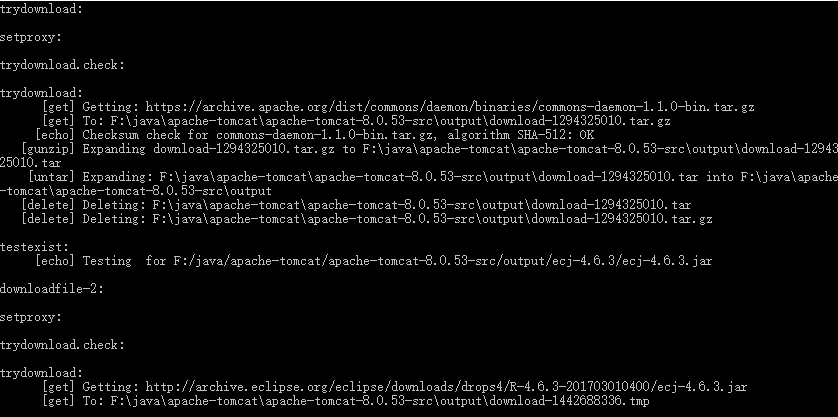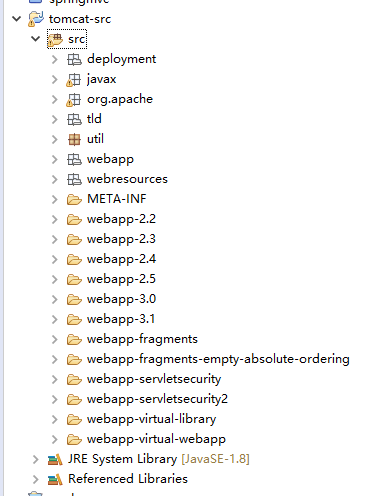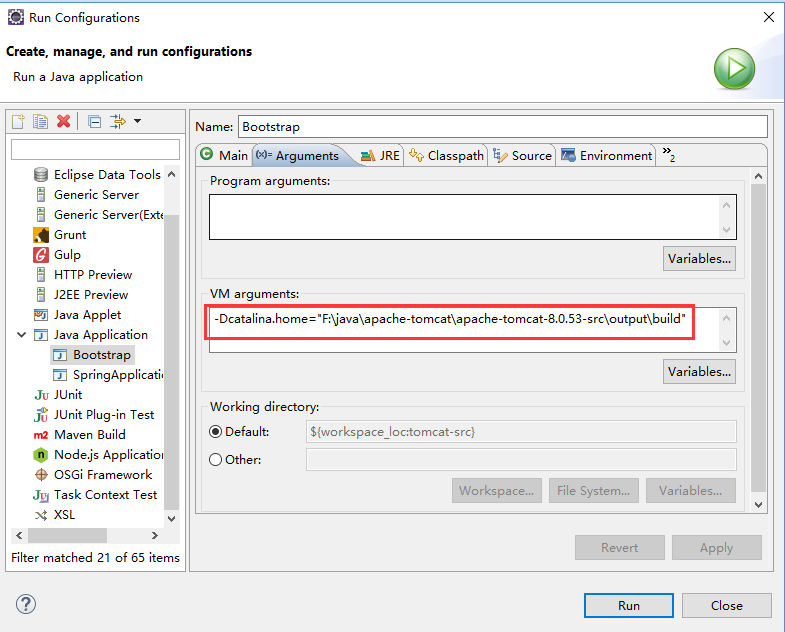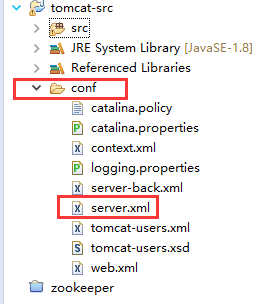Tomcat源码分析-开篇(Tomcat源码部署运行 Ant方式)
一、安装配置Ant
(1)下载Ant
下载地址:https://ant.apache.org/bindownload.cgi

下载完成后解压即用。
(2)配置Ant环境变量
配置ANT_HOME=F:\java\apache-ant-1.10.7
path中添加:%ANT_HOME%\bin
(3)查看Ant版本
命令:ant -v

到这里Ant已经安装好了。下面就准备开始导入Tomcat源码...
二、导入Tomcat源码
(1)下载tomcat源码
下载地址:https://archive.apache.org/dist/tomcat/
(2)修改build.properties文件
在根目录我们可以看到有一个build.properties.default文件。将其更名为build.properties,打开,找到base.path=….;并将其改为该文件的目录+/output。当然,你也可以随便写什么路径,只要你能找到就行。

(3)下载相关的依赖jar
打开cmd,将进入tomcat源码的根目录,输入ant 命令(这个可能会花一点时间),如图:

下载完成后目录如下:

(4)新建java项目
新建一个java Project,我自已把它命名为tomcat-src,然后将tomcat源码下的java和test两个文件夹以File System方式导入项目的根目录。
(5)导入依赖包

(6)配置启动参数


到此可以直接通过启动 Bootstrap 类中的main 方法启动tomcat服务了。
结束了 !!!
三、这个Tomcat源码项目如何启动其它web应用?(附加内容)
(1)在新建的java项目中创建一个conf 目录,并将源码目录下conf 的server.xml 放进去

(2)打开Bootstrap.java ,找到这个类的main方法,修改args参数(源码启动的时候 args参数为空值)
修改的这个args参数 在启动Bootstrap 时,会去加载这个 server.xml 文件
public static void main(String args[]) { // 在这时修改args参数,因为直接启动这个main方法时,args参数为空 args = new String[]{"-config", System.getProperty("user.dir") + "\\conf\\server.xml", "start"}; if (daemon == null) { // Don't set daemon until init() has completed Bootstrap bootstrap = new Bootstrap(); try { bootstrap.init(); } catch (Throwable t) { handleThrowable(t); t.printStackTrace(); return; } daemon = bootstrap; } else { // When running as a service the call to stop will be on a new // thread so make sure the correct class loader is used to prevent // a range of class not found exceptions. Thread.currentThread().setContextClassLoader(daemon.catalinaLoader); } // 省略若干代码... }
(3)修改刚才加进去的这个 server.xml 文件

代码可以从下面进行拷贝
<Host name="localhost" appBase="webapps" unpackWARs="true" autoDeploy="true"> <!-- SingleSignOn valve, share authentication between web applications Documentation at: /docs/config/valve.html --> <!-- <Valve className="org.apache.catalina.authenticator.SingleSignOn" /> --> <!-- Access log processes all example. Documentation at: /docs/config/valve.html Note: The pattern used is equivalent to using pattern="common" --> <Valve className="org.apache.catalina.valves.AccessLogValve" directory="logs" prefix="localhost_access_log" suffix=".txt" pattern="%h %l %u %t "%r" %s %b" /> <Context path="" reloadable="true" docBase="D:\workspace-neno\springmvc\src\main\webapp" workDir="D:\workspace-neno\springmvc\work"> <Loader className="org.apache.catalina.loader.MyDevLoader" reloadable="true" debug="1" useSystemClassLoaderAsParent="false" /> </Context> </Host>
(4)添加 org.apache.catalina.loader.MyDevLoader 这个类(就是上面截图圈起来的那个类)
在 org.apache.catalina.loader 包下新建一个类,名称为 MyDevLoader (当然可以改成你想要的名字,只要保证和server.xml 中 Loader 中的className一致就行) ;
建完类之后,直接拷贝我下面的代码:(备注:我这里用的是tomcat8,如果是tomcat7/tomcat9 的话可能要修改一些报错的内容)
package org.apache.catalina.loader; import java.io.File; import java.io.FileFilter; import java.io.FileReader; import java.io.IOException; import java.io.LineNumberReader; import java.net.MalformedURLException; import java.net.URL; import java.util.ArrayList; import java.util.Iterator; import java.util.List; import java.util.StringTokenizer; import javax.servlet.ServletContext; import org.apache.catalina.LifecycleException; /** * 自定义DevLoader类 * @author Administrator * */ public class MyDevLoader extends WebappLoader { private static final String info = "org.apache.catalina.loader.DevLoader/1.0"; private String webClassPathFile = ".#webclasspath"; private String tomcatPluginFile = ".tomcatplugin"; public MyDevLoader() { } public MyDevLoader(ClassLoader parent) { super(parent); } public void startInternal() throws LifecycleException { log("Starting DevLoader"); super.startInternal(); ClassLoader cl = super.getClassLoader(); if (!(cl instanceof WebappClassLoader)) { logError("Unable to install WebappClassLoader !"); return; } WebappClassLoader devCl = (WebappClassLoader) cl; List webClassPathEntries = readWebClassPathEntries(); StringBuffer classpath = new StringBuffer(); for (Iterator it = webClassPathEntries.iterator(); it.hasNext();) { String entry = (String) it.next(); File f = new File(entry); if (f.exists()) { if ((f.isDirectory()) && (!(entry.endsWith("/")))) f = new File(entry + "/"); try { URL url = f.toURL(); // devCl.addRepository(url.toString()); devCl.addURL(url); classpath.append(f.toString() + File.pathSeparatorChar); log("added " + url.toString()); } catch (MalformedURLException e) { logError(entry + " invalid (MalformedURL)"); } } else { logError(entry + " does not exist !"); } } String cp = (String) getServletContext().getAttribute("org.apache.catalina.jsp_classpath"); StringTokenizer tokenizer = new StringTokenizer(cp, File.pathSeparatorChar + ""); while (tokenizer.hasMoreTokens()) { String token = tokenizer.nextToken(); if ((token.charAt(0) == '/') && (token.charAt(2) == ':')) { token = token.substring(1); } classpath.append(token + File.pathSeparatorChar); } getServletContext().setAttribute("org.apache.catalina.jsp_classpath", classpath.toString()); log("JSPCompiler Classpath = " + classpath); } protected void log(String msg) { System.out.println("[DevLoader] " + msg); } protected void logError(String msg) { System.err.println("[DevLoader] Error: " + msg); } protected List readWebClassPathEntries() { List rc = null; File prjDir = getProjectRootDir(); if (prjDir == null) return new ArrayList(); log("projectdir=" + prjDir.getAbsolutePath()); rc = loadWebClassPathFile(prjDir); if (rc == null) rc = new ArrayList(); return rc; } protected File getProjectRootDir() { File rootDir = getWebappDir(); FileFilter filter = new FileFilter() { public boolean accept(File file) { return (file.getName().equalsIgnoreCase(webClassPathFile) || file.getName().equalsIgnoreCase(tomcatPluginFile)); } }; while (rootDir != null) { File[] files = rootDir.listFiles(filter); if ((files != null) && (files.length >= 1)) return files[0].getParentFile(); rootDir = rootDir.getParentFile(); } return null; } protected List loadWebClassPathFile(File prjDir) { File cpFile = new File(prjDir, this.webClassPathFile); if (cpFile.exists()) { FileReader reader = null; try { List rc = new ArrayList(); reader = new FileReader(cpFile); LineNumberReader lr = new LineNumberReader(reader); String line = null; while ((line = lr.readLine()) != null) { line = line.replace('\\', '/'); rc.add(line); } return rc; } catch (IOException ioEx) { if (reader != null) ; return null; } } return null; } protected ServletContext getServletContext() { // return ((Context) getContainer()).getServletContext(); return this.getContext().getServletContext(); } protected File getWebappDir() { File webAppDir = new File(getServletContext().getRealPath("/")); return webAppDir; } }
(5)启动 BootStrap 中的main方法
这样你其它的web项目就启动了,这个就相当于eclipse插件中那个猫的图标按钮功能!




 浙公网安备 33010602011771号
浙公网安备 33010602011771号